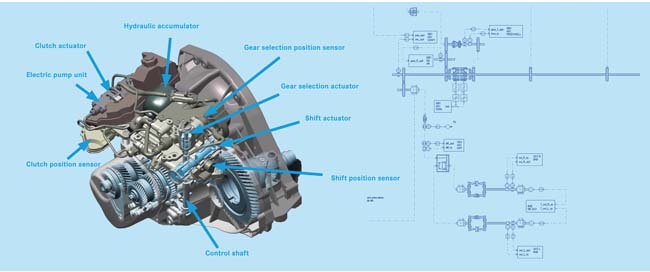Fast App: Designing the ‘Brains’ for Automated Manual Transmissions
LMS Imagine.Lab AMESim helps Renault bridge the development gap among mechanics, electronics and control software in this hard-to-design system.
February 1, 2011
By DE Editors
 |
One feature many of today’s consumers look for in a new car is an automated manual transmission (AMT)—systems that behave like automatics, but also allow drivers to shift gears electronically using a push-button command without a clutch pedal. AMTs combine the fuel efficiency, performance and control of manual systems with the convenience of automatics, an especially handy feature in stop-and-go traffic.
With the ease and convenience appreciated by many drivers facing daily traffic congestion, automakers are equipping a growing number of new vehicle models with these types of transmissions. Indeed, a report from market research firm Frost and Sullivan predicts 15% of small cars will likely feature AMTs by 2012.
These complex mechatronics systems are difficult to design, however, because their performance depends on the operation of three different subsystems all working together in perfect synchronization: an electromechanical actuator that shifts the gears, electronic sensors that monitor vehicle status and software embedded in the transmission control unit (TCU)—the “brains” that control the powertrain.
Ordinarily, up to a year is required to define overall functional requirements, design the actuator mechanics, develop and calibrate TCU software, and validate the complete system. Software development and calibration are particularly troublesome bottlenecks, because these tasks typically require extensive trial-and-error physical testing cycles that cannot be performed until hardware prototypes are built. By then, mechanical and electronics designs are nearly finalized and cannot be changed appreciably to improve powertrain performance. Considerable time is spent troubleshooting problems near the end of design, rather than refining TCU control strategies.
In a pioneering initiative, French automaker Renault S.A. is streamlining the AMT development process with a simulation-based approach: It’s using LMS Imagine.Lab AMESim 1D simulation software to predict the performance and real functionality of complex multi-domain systems using a single, unified, physics-based model. Engineers drag, drop and interconnect simple icons to graphically create the model, displayed on the screen with a working sketch showing relationships of all the various elements to predict the behavior of an entire AMT system.
“Using the multi-domain simulation approach based on LMS Imagine.Lab AMESim, we can see early in development how all the various parts of the complex AMT system will operate together—mechanics, electronics and control software,” explains Edouard Négre, senior design engineer in the Renault Powertrain Control Engineering Division. “With this understanding of the complete mechatronics system, we can readily optimize the entire design up front in development and avoid many late-stage problems and delays.”
 |
Throughout the process, the LMS Imagine.Lab AMESim model evolves as the design progresses and system requirements are defined in greater detail. Renault most recently used the method to develop a new actuator for one of its existing AMT models, redefine the existing TCU control strategy and evaluate the entire AMT performance.
A simplified model was initially created to define overall powertrain load constraints and size the major mechanical components, including hydraulics, electrical generator and gear reductions. Next, parameters from design drawings and technical data from engineering specifications were added to plot overall performance curves, define basic control commands and determine the overall response of the complete mechatronics system. In these conceptual phases, engineers explored the behavior of various alternative mechatronics configurations—in particular, various actuator designs to provide smooth gear shifting—until the best powertrain performance was achieved.
Based on these simulation results, the model was then used to develop control algorithms used as a basis for co-simulation between the LMS Imagine.Lab AMESim and the real-time software development and integration platform to develop first-order transmission control unit (TCU) logic software. In this software-in-the-Loop (SiL) approach, AMESim was used to simulate the powertrain hardware; it essentially provided a virtual engine and transmission as stand-ins while the actual hardware was still in development.
Finally, the TCU software performance was validated and calibrated using a hardware-in-the-loop (HiL) approach to exercise the system model in real time. On a test rig, a TCU with control code embedded in the electrics sent signals to operate a physical prototype of an AMT actuator based on simulated load and sensor signals generated by LMS Imagine.Lab AMESim for the rest of the powertrain. In this way, engineers fine-tuned the TCU software to achieve optimal powertrain performance according to fuel efficiency, dynamic response and other operational factors.
“Simulation-based development using LMS Imagine.Lab AMESim enabled Renault to shorten AMT development time considerably,” Négre reports. “Refining the performance of the mechatronics system early in development avoids problems that take considerable time to resolve later in the development cycle. Moreover, using SiL and HiL approaches to develop, calibrate and validate TCU software, in parallel with hardware development and fabrication, constitutes an immense time savings.
“The models developed and lessons learned with this project will be used as a basis for further time and development savings in the future,” he adds. “With this process, Renault will be launching more new vehicle models with AMTs months sooner than would otherwise be possible.”
More Info:
LMS
Subscribe to our FREE magazine, FREE email newsletters or both!
About the Author
DE’s editors contribute news and new product announcements to Digital Engineering.
Press releases may be sent to them via [email protected].






